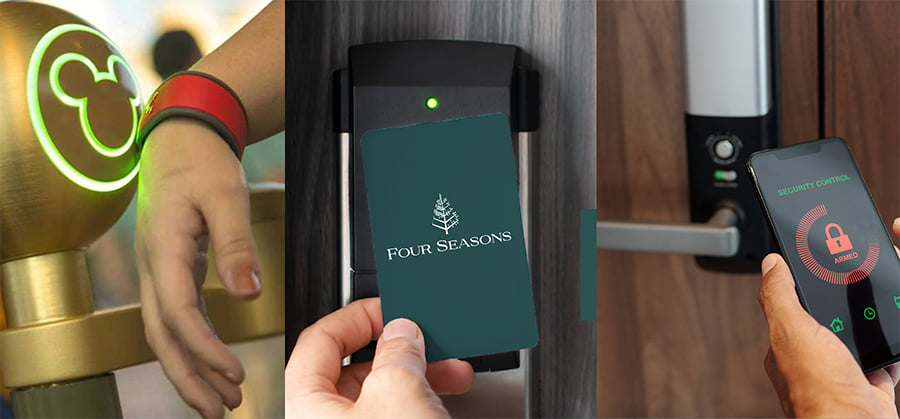It's been a decade since we last delved into the RFID vs NFC debate in our industry. Now, it's time to revisit the article we published on Techradar.com back in 2013.
With over 100 million RFID wristbands in circulation, and their widespread use in live events worldwide for access control and cashless payments, it begs the question: What insights have we gained in the past 10 years?
Let's pause for a moment and revisit the basics that lay the groundwork for our understanding.
What is RFID Technology?
RFID stands for Radio Frequency Identification, a wireless technology that tracks and identifies objects using electromagnetic fields. It consists of an antenna and a chip storing information about the attached object. A reader sends an electromagnetic signal to the tag, which responds with its stored information. RFID finds applications in various industries like retail, manufacturing, healthcare, and logistics. For instance, it tracks products in retail stores and medical equipment in hospitals, ensuring accurate inventory management. Additionally, it can serve as a means of access control, acting as a digital substitute for traditional paper tickets at live events.
What is NFC Technology?
NFC, or Near Field Communication, is another wireless technology used for communication between devices. It operates at a frequency of 13.56 MHz and allows two devices to exchange information when they are approximately 4 cm or less apart. An NFC device can operate in three modes: reader/writer (for reading tags in NFC posters, for instance), card emulation (for making payments), and peer-to-peer (for exchanging data). Like RFID, NFC also uses electromagnetic induction to transmit information, making it ideal for secure and quick transactions such as contactless payments, and digital content sharing. NFC has become closely associated with smartphones, as the majority of phones now come equipped with NFC functionality. Smartphones have become the primary means through which individuals interact with this technology.
What are the Key Differences between RFID and NFC?
RFID and NFC both use radio frequencies to communicate data, but there are key differences. RFID technology operates over multiple distances from a few centimeters to over 100 meters depending on the RFID frequency, while NFC enables secure transactions and data transfers at close range. Unlike RFID, NFC supports two-way communication for interactive applications. NFC is a prevalent feature in smartphones, as the reader function relies on power to operate. In contrast to the non-powered RFID technology typically used in our RFID festival wristbands and key cards.
5 Benefits of NFC and RFID Technology
- Cost-effectiveness: NFC and RFID technology are affordable solutions for businesses seeking to enhance operational efficiency. RFID tags outlast and are more secure than traditional barcodes and can be read faster, reducing queues and costs associated with ‘will call' tickets exchange.
- Convenience: NFC and RFID technology enable contactless payments, allowing customers to securely make purchases without cash or cards. This makes shopping more convenient as they can simply tap their device or wearable on a payment terminal to complete the transaction, eliminating the need to wait in line.
- Accessibility: NFC and RFID technology make it easier for consumers to access secure resources, such as store loyalty cards, event tickets, and student ID cards. With these technologies, customers can simply tap their smartphone or wearable on a reader to gain access to the resource without having to manually enter any information.
- Personalization: Companies can utilize NFC and RFID technology to provide personalized experiences to event attendees and hotel guests. For instance, retailers can use NFC tags to deliver targeted promotions based on past purchases and preferences at an event. Moreover, this technology enables companies to create interactive guest experiences, like the Disney Magic Band.
- Security: Both NFC and RFID technology offer superior data security compared to traditional barcodes or passwords. They encrypt data transmission.
Overall, NFC and RFID technology are great tools for both businesses and consumers alike.
RFID Wristbands & Cards vs. NFC-Enabled Smartphones

In our 2013 Techradar article, we pondered whether the wristband would be superseded by NFC in smartphones for access control, similar to how RFID wristbands replaced paper tickets, and the impending obsolescence of magstripe cards due to RFID card technology.
Even after a decade, RFID wristbands and cards continue to be the primary means of enabling access control and cashless payments. These physical products are not only essential for the event and hotel industries but also play a crucial role in the continued evolution of cashless bank cards.
Why RFID Is Preferred Over NFC in Events and Hospitality Industry?
Let's explore the common goals of the live event and hotel industries, where ID&C excels in its expertise and authority.
- Create Anticipation Before the Experience: The physical token such as a wristband can be sent out as part of the customer’s pre-arrival experience. This helps build excitement and anticipation for the event, enabling them to plan their entire visit in advance.
- Guest Experience: Utilize RFID technology to enhance guest interactions seamlessly and without interruption. This empowers staff to prioritize personalized guest interactions, instead of getting caught up in manual data entry and information checks behind a computer. By removing staff interaction and relying exclusively on smartphones for hotel check-in, guests may perceive a decline in service quality or even feel a sense of missing out due to the absence of personalized guidance.
- Inspire the Intent to Return: Physical tokens such as RFID cards and wristbands are invaluable in creating a lasting reminder of a positive experience that will entice guests to return for a future event or stay.
What wonders await us in the next decade?
Advancements in battery technology have made low-energy Bluetooth (BLE) and Cellular radio technologies more accessible and practical for use in labels and wearable devices. Combining the benefits of these dual technologies is becoming increasingly common, particularly in the event and hotel industry. The wristband remains the optimal physical token for facilitating these innovative technology combinations. ID&C is already at the forefront of these integrated technology applications, and will continue to drive innovation in this space.







